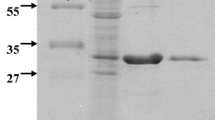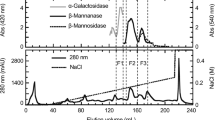Abstract
In our previous study using a fluorescently labeled cohesin biomarker, we detected and identified a putative cellulosomal mannanase belonging to the glycosyl hydrolase family 26 from Clostridium cellulovorans in xylan-containing cultures. In this study, a mannanase gene, manB from C. cellulovorans, was expressed in Escherichia coli. The optimal pH of a purified enzyme was around pH 7.0 and the optimal temperature was 40°C. The purified mannanase B (ManB) showed high hydrolytic activity toward galactomannan. An assembly of ManB with mini-CbpA, which contains a carbohydrate-binding module that provides proximity to insoluble substrates, increased the activity toward galactomannan [locust bean gum (LBG) and guar gum] 1.7- and 2.0-fold over those without mini-CbpA. We tested the synergistic effects on galactomannan (LBG and guar gum) degradation using cellulosomal mannanase ManB with cellulosomal endoglucanase E, which was predicted to have mannanase activity in C. cellulovorans as a cellulolytic complex. When assembled with the mini-CbpA, the mixture of endoglucanase E (EngE) and ManB at a molar ratio of 1:2 showed the highest synergistic effect (2.4-fold) on LBG. The mixture at a ratio of 1:3 showed the highest synergistic effect (2.8-fold) on guar gum. These synergistic actions indicated that ManB assembled with mini-CbpA hydrolyzed insoluble galactomannan, which in turn promoted soluble galactomannan degradation by EngE.





Similar content being viewed by others
References
Bradford MM (1976) A rapid and sensitive method for the quantitation of microgram quantities of protein utilizing the principle of protein-dye binding. Anal Biochem 72:248–254
Cantarel BL, Coutinho PM, Rancurel C, Bernard T, Lombard V, Henrissat B (2009) The carbohydrate-active enzymes database (CAZy): an expert resource for glycogenomics. Nucleic Acids Res 37:233–238
Cho W, Jeon SD, Shim HJ, Doi RH, Han SO (2010) Cellulosomic profiling produced by Clostridium cellulovorans during growth on different carbon sources explored by the cohesin marker. J Biotechnol 145:233–239
Demain AL, Newcomb M, Wu JH (2005) Cellulase, clostridia, and ethanol. Microbiol Mol Biol Rev 69:124–154
Fontes CM, Gilbert HJ (2010) Cellulosomes: highly efficient nanomachines designed to deconstruct plant cell wall complex carbohydrates. Annu Rev Biochem 79:655–681
Franco PF, Ferreira HM, Filho EX (2004) Production and characterization of hemicellulase activities from Trichoderma harzianum strain T4. Biotechnol Appl Biochem 40:255–259
Giallo J, Gaudin C, Belaich JP (1985) Metabolism and solubilization of cellulose by Clostridium cellulolyticum H10. Appl Environ Microbiol 49(5):1216–1221
Han SO, Yukawa H, Inui M, Doi RH (2003a) Regulation of expression of cellulosomal cellulase and hemicellulase genes in Clostridium cellulovorans. J Bacteriol 185:6067–6075
Han SO, Yukawa H, Inui M, Doi RH (2003b) Transcription of Clostridium cellulovorans cellulosomal cellulase and hemicellulase genes. J Bacteriol 185:2520–2527
Han SO, Yukawa H, Inui M, Doi RH (2005) Effect of carbon source on the cellulosomal subpopulations of Clostridium cellulovorans. Microbiology 151:1491–1497
Hilden L, Johansson G (2004) Recent developments on cellulases and carbohydrate-binding modules with cellulose affinity. Biotechnol Lett 26:1683–1693
Jeon E, Hyeon JE, Suh DJ, Suh YW, Kim SW, Song KH, Han SO (2009) Production of cellulosic ethanol in Saccharomyces cerevisiae heterologous expressing Clostridium thermocellum endoglucanase and Saccharomycopsis fibuligera β-glucosidase genes. Mol Cells 28:369–373
Lamed R, Setter E, Bayer EA (1983) Characterization of a cellulose-binding, cellulase-containing complex in Clostridium thermocellum. J Bacteriol 156:828–836
Miller GL, Blum R, Glennon WE, Burton AL (1960) Measurement of carboxymethyl cellulase activity. Anal Biochem 1(2):127–132
Miras I, Schaeffer F, Beguin P, Alzari PM (2002) Mapping by site-directed mutagenesis of the region responsible for cohesin-dockerin interaction on the surface of the seventh cohesin domain of Clostridium thermocellum CipA. Biochemistry 41:2115–2119
Moreira LR, Filho EX (2008) An overview of mannan structure and mannan-degrading enzyme systems. Appl Microbiol Biotechnol 79:165–178
Murashima K, Chen CL, Kosugi A, Tamaru Y, Doi RH, Wong SL (2002a) Heterologous production of Clostridium cellulovorans engB, using protease-deficient Bacillus subtilis, and preparation of active recombinant cellulosomes. J Bacteriol 184:76–81
Murashima K, Kosugi A, Doi RH (2002b) Synergistic effects on crystalline cellulose degradation between cellulosomal cellulases from Clostridium cellulovorans. J Bacteriol 184:5088–5095
Murashima K, Kosugi A, Doi RH (2003) Synergistic effects of cellulosomal xylanase and cellulases from Clostridium cellulovorans on plant cell wall degradation. J Bacteriol 185:1518–1524
Park JS, Matano Y, Doi RH (2001) Cohesin-dockerin interactions of cellulosomal subunits of Clostridium cellulovorans. J Bacteriol 183:5431–5435
Pham TA, Berrin JG, Record E, To KA, Sigoillot JC (2010) Hydrolysis of softwood by Aspergillus mannanase: role of a carbohydrate-binding module. J Biotechnol 148:163–170
Raman B, Pan C, Hurst GB, Rodriguez M Jr, McKeown CK, Lankford PK, Samatova NF, Mielenz JR (2009) Impact of pretreated switchgrass and biomass carbohydrates on Clostridium thermocellum ATCC 27405 cellulosome composition: a quantitative proteomic analysis. PLoS ONE 4:e5271
Rincon MT, Ding SY, McCrae SI, Martin JC, Aurilia V, Lamed R, Shoham Y, Bayer EA, Flint HJ (2003) Novel organization and divergent dockerin specificities in the cellulosome system of Ruminococcus flavefaciens. J Bacteriol 185:703–713
Schaeffer F, Matuschek M, Guglielmi G, Miras I, Alzari PM, Beguin P (2002) Duplicated dockerin subdomains of Clostridium thermocellum endoglucanase CelD bind to a cohesin domain of the scaffolding protein CipA with distinct thermodynamic parameters and a negative cooperativity. Biochemistry 41:2106–2114
Sleat R, Mah RA, Robinson R (1984) Isolation and characterization of an anaerobic, cellulolytic bacterium, Clostridium cellulovorans sp. nov. Appl Environ Microbiol 48:88–93
Tamaru Y, Doi RH (1999) Three surface layer homology domains at the N terminus of the Clostridium cellulovorans major cellulosomal subunit EngE. J Bacteriol 181:3270–3276
Tamaru Y, Doi RH (2000) The engL gene cluster of Clostridium cellulovorans contains a gene for cellulosomal manA. J Bacteriol 182:244–247
Vlasenko E, Schulein M, Cherry J, Xu F (2009) Substrate specificity of family 5, 6, 7, 9, 12, and 45 endoglucanases. Bioresour Technol 101:2405–2411
Ximenes EA, Chen H, Kataeva IA, Cotta MA, Felix CR, Ljungdahl LG, Li XL (2005) A mannanase, ManA, of the polycentric anaerobic fungus Orpinomyces sp. strain PC-2 has carbohydrate binding and docking modules. Can J Microbiol 51:559–568
Acknowledgments
We are grateful to Ka Young Shin for skilled technical assistance. This work was supported in part by a grant from the BioGreen 21 Program, Rural Development Administration (Code #20080401034002) and the Technology Development Program for Agriculture and Forestry, Ministry for Agriculture, Forestry and Fisheries, Republic of Korea (no. 309016-5).
Author information
Authors and Affiliations
Corresponding author
Rights and permissions
About this article
Cite this article
Jeon, S.D., Yu, K.O., Kim, S.W. et al. A celluloytic complex from Clostridium cellulovorans consisting of mannanase B and endoglucanase E has synergistic effects on galactomannan degradation. Appl Microbiol Biotechnol 90, 565–572 (2011). https://doi.org/10.1007/s00253-011-3108-7
Received:
Revised:
Accepted:
Published:
Issue Date:
DOI: https://doi.org/10.1007/s00253-011-3108-7




